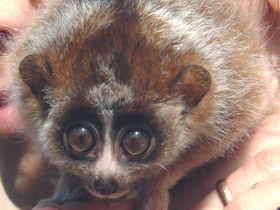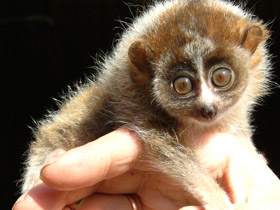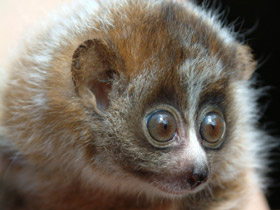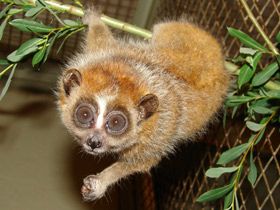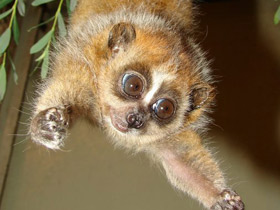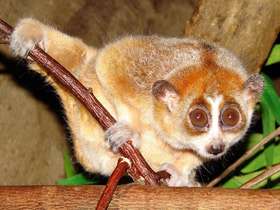The pygmy slow loris (Xanthonycticebus pygmaeus)
The pygmy slow loris (Xanthonycticebus pygmaeus) is a species of slow loris found east of the Mekong River in Vietnam, Laos, eastern Cambodia, and China. It occurs in a variety of forest habitats, including tropical dry forests, semi-evergreen, and evergreen forests. It was originally classified within Nycticebus until it was transferred to the genus Xanthonycticebus in 2022.
History, taxonomy, and phylogeny
The pygmy slow loris was first described scientifically by J. Lewis Bonhote in 1907. The description was based on a male specimen sent to him by J. Vassal, a French physician who had collected the specimen from Nha Trang, Vietnam (then called Annam, a French Protectorate) in 1905. In 1939, Reginald Innes Pocock combined all slow lorises into a single species, Nycticebus coucang.
In an influential 1953 publication, primatologist William Charles Osman Hill also consolidated all the slow lorises in one species, Nycticebus coucang, and considered other forms distinct at the subspecies level. Osman Hill thus listed Nycticebus coucang pygmaeus, while acknowledging that "it may be deemed necessary to accede this form specific rank." In 1960, Dao Van Tien reported a species from Hòa Bình Province, Vietnam, that he called N. intermedius, but it turned out that his specimens were merely adults of the pygmy slow loris, which had originally been described on the basis of a juvenile. After studying slow lorises from Indochina, primatologist Colin Groves proposed that the pygmy slow loris was morphologically unique enough to be considered a distinct species. The validity of this opinion was later corroborated by studies of chromosomal structure, genetic distance determined by protein variation at polymorphic loci, and mitochondrial DNA restriction enzyme analysis. Nekaris and Nijman (2022) combined morphological, behavioural, karyotypical and genetic data and suggested that pygmy lorises are best placed in their own genus, Xanthonycticebus.
The phylogenetic relationships within the genus Nycticebus have been studied with modern molecular techniques, using DNA sequences derived from the mitochondrial DNA markers D-loop and cytochrome b from 22 slow loris individuals. In this analysis, most of the recognized lineages of Nycticebus, including the pygmy slow loris, were shown to be genetically distinct, and the species was shown to have diverged earlier than the other slow loris species, beginning perhaps 2.7 million years ago. Analysis of nucleotide sequence diversity from individuals taken from the boundary areas between southern China and Vietnam (a region of sympatry between the pygmy slow loris and the Bengal slow loris) show that the pygmy slow loris is not subject to the same introgressive hybridization as the Bengal slow loris (N. bengalensis). The authors of the study suggest that the low polymorphism of pygmy slow lorises may be due to a founder effect, and that the individuals they used in the study originate from an ancestor that lived in middle or southern Vietnam between 1860 and 7350 years ago.
Particularities and habitat area
Nycticebus pygmaeus is a rare species of strepsirrhine primate of the family Lorisidae.
Nycticebus pygmaeus inhabits the forests of Laos, Cambodia, Vietnam and southern China, where it lives mainly solitary in its individual territory. Communication between the animals, whose territories are adjacent, is mainly by scent and sound. Nycticebus pygmaeus have many special skin glands that secrete an odorous secretion. They are located under the chin, on the inner arm near the elbow, on the chest and near the genitals. The secretions of these glands, together with the odour of faeces, are perceived by the animals as signals of the presence of this or that sex in a particular area and in a particular physiological state. Nycticebus pygmaeus usually meet only during the feeding period. In doing so, they send signals to each other by means of distinctive postures.
Diet
The pygmy slow loris is omnivorous, feeding on termites, ants, other insects, and fruit. Insects are captured with one or both hands while standing or hanging upside-down from a branch. Insect prey is typically consumed at heights less than 10 m (33 ft). A Vietnamese study concluded that the diet of the pygmy slow loris consists largely of tree exudates (gum) (63%) and animal prey (33%), with other food types making up the remainder. A study on recently reintroduced individuals found similar results—40% insects, 30% gum, and 30% other exudates. The pygmy slow loris will gouge trees to feed on the released exudates. Although tree gum is not as nutrient-rich as its preferred diet, it is available year-round. The pygmy slow loris is a specialized gummivore, a trait that helps it overcome difficulties in finding food during times of shortage. Unable to leap from tree to tree, the pygmy slow loris has a restricted range from which it may obtain food sources. Having generalist dietary preferences allows them to overcome difficult environmental conditions; gum allows them to live at a low energy level with a reduced metabolism. Trees from which exudates are eaten are from the following families: Sapindaceae (Sapindus), Euphorbiaceae (Vernicia), Fabaceae (Saraca), Anacardiaceae (Spondias), and Burseraceae. Feeding on gum takes place over a time period ranging from one to twenty minutes and involves intense licking, sometimes accompanied by audible scratching and bark-breaking sounds. Feeding on exudates usually occurs at heights over 8 m (26 ft). The seasonal color variation that occur in the dorsal stripe of Vietnamese individuals may be related to the need to engage in exudate feeding.
The diet of the pygmy slow loris is seasonal. In north Vietnam, for example, the winter is characterized by low rainfalls and temperatures as low as 5 °C in the north of its range, when there is little growth of vegetation in forests, few insects, and limited food resources. The pygmy slow loris will also consume insects that have been exposed by its bamboo-gouging activities. It will use its toothcomb to clean an area of lichens and fungi prior to gouging. The animals conserve energy in the colder winter months by reducing movement, often to the point of complete inactivity.
Reproduction
The female is sexually mature at 9 months and the male at 17-20 months. Reproduction of Nycticebus pygmaeus is not strictly seasonal, but in the wild cubs are born more often in the season with the richest food resources. Pregnancy lasts 188 days and, under favourable conditions, females give birth every 12-18 months. Usually one cub is born and immediately after birth it clings to the mother's chest hair. The calf stays close to the mother's teat for the first 2 or 3 days and then moves onto her back. The female may leave a week-old calf in an isolated place on a branch while foraging for food. If the calf is in danger, it emits a loud, distinctive chirp, and the mother rushes to its rescue. The female carries her young for 35-50 days and feeds them with milk for more than 4 months, while the male does not participate in the rearing of the young.
Conservation
The pygmy slow loris has declined in numbers as a result of extensive habitat degradation throughout its range, including north-eastern Cambodia, the Yunnan Province of China, and Vietnam. In Yunnan province, nearly all primary evergreen forests have vanished and secondary forests have been heavily degraded; as of 2005, forest cover has been reduced by 42% since the mid-1990s. The use of defoliants, such as Agent Orange, during the Vietnam War and the ongoing clearing of forests in Vietnam have resulted in a considerable loss of habitat. As of 2003, the forest cover had been reduced to 30% of its original area, with only 10% of the remaining forest consisting of the closed-canopy forests preferred by the pygmy slow loris.
In captivity
The first documented pygmy slow loris in North America was kept at Hawaii's Honolulu Zoo in 1968. In 1986, about 37 pygmy lorises were exported from Vietnam and Laos to Sweden. A year later, several pairs caught from the wild were transferred to zoos in Cincinnati, San Diego, and the Duke Lemur Center. In 1994, the Association of Zoos and Aquariums established a Species Survival Plan for the species, following a proposal by the Global Captive Action Plan for Primates to create a breeding program to maintain its genetic diversity. As of 2008, the captive population in North America had grown to 74 individuals, with most of them born at the San Diego Zoo; as of 2013, the species is the most common lorisid primate kept in North American zoos. About 175 pygmy lorises live in breeding facilities worldwide.

















